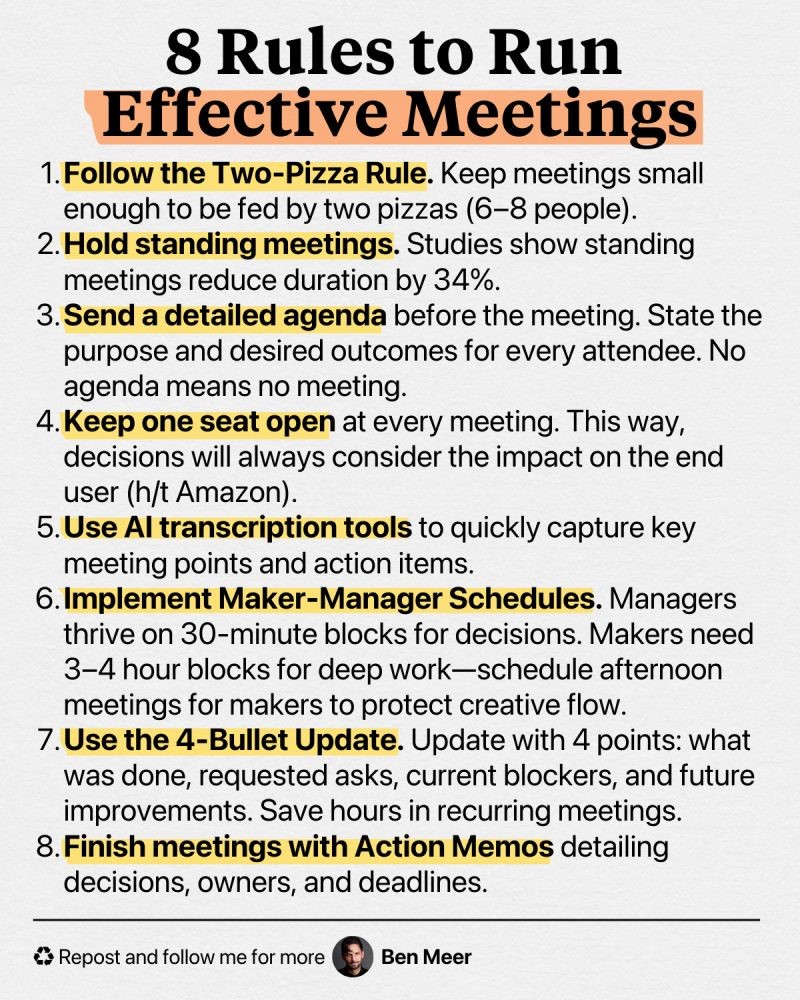3. Run Efficient Meetings and Collaborative Decision-Making Sessions
We’ve all experienced those meetings—the kind that feel endless, unproductive, and frankly, could’ve just been an email. The discussion rambles, decisions stall, and you start daydreaming about anything more exciting (like reorganizing your sock drawer).
But here’s the thing: meetings don’t have to be a painful drain on productivity. With clear planning, effective facilitation, and structured decision-making, you can turn even the toughest meetings into concise, engaging, and genuinely productive sessions.
Ready to run meetings that people actually enjoy (or at least don’t dread)? Here’s your practical, straightforward guide to efficient meetings and collaborative decision-making.
Ben Meer’s post offers 8 practical tips to transform meetings from time-wasters into productivity boosters.

Why Efficient Meetings Matter
Time is valuable. Poorly run meetings waste time, frustrate teams, and reduce productivity. But efficient meetings enhance collaboration, clarify decisions, and propel teams forward—quickly and effectively.
Efficient meetings help you:
- Achieve clear, productive outcomes.
- Improve team morale and engagement.
- Boost overall productivity and decision quality.
Step 1: Start with Clear Objectives and an Agenda
Great meetings start before the meeting even begins—with clear objectives and a concise agenda sent in advance.
How to prepare:
- Define the meeting’s purpose (“Decide marketing strategy for Q3”).
- Outline key discussion points and decisions needed.
- Send a brief agenda at least 24 hours beforehand.
Examples
Send an agenda the day before, stating clearly:
- Quick update on marketing results (5 mins)
- Discuss and choose Q3 marketing strategy (15 mins)
- Assign action items (5 mins)
Everyone arrives prepared and clear about expectations.
Step 2: Stick to Your Schedule (Time is Gold!)
Respect participants’ time by starting and ending promptly. Set clear time limits for each agenda item—and stick to them!
Effective scheduling tips:
- Communicate start and end times in advance.
- Use a timer or designate someone to watch the clock.
- Gently redirect conversations that drift off-topic.
Example
Step 3: Facilitate Participation from Everyone
Great decisions require diverse perspectives. Actively involve everyone, ensuring each person feels heard and valued.
Encouraging balanced participation:
- Invite input explicitly (“We haven’t heard from Juan yet—Juan, your thoughts?”)
- Use quick polls or go-around-the-table methods to gather diverse views.
- Keep track of dominant voices and encourage quieter participants.
Example
Step 4: Use Structured Decision-Making Methods
Decisions stall without clear processes. Structured methods help groups make clear, effective, and timely decisions.
Effective decision-making methods:
- Dot voting: Each member votes for top choices quickly using stickers or virtual tools.
- Pros/Cons lists: Quickly outline benefits and drawbacks to clarify options.
- Consensus method: Discuss until all members can agree comfortably, or at least support the decision fully.
Example
Step 5: Assign Roles and Responsibilities
Every meeting should conclude with clear, specific actions assigned. Clearly state who’s responsible for each task, what’s expected, and by when.
Assign actions:
- Summarize decisions and next steps at the meeting’s end.
- Confirm who’s responsible for each action item explicitly.
- Provide deadlines and confirm understanding.
Example
Step 6: Follow Up Quickly and Clearly
Prompt follow-up ensures decisions turn into action. Send a brief summary immediately after the meeting.
Effective follow-up communication:
- Quickly summarize decisions and assigned actions.
- Clearly restate deadlines and responsibilities.
- Keep it concise—bullet points work best.
Examples
Send a quick email right after the meeting:
Meeting Summary
- Marketing plan (Sara) due Wednesday.
- Proposal distribution (Tom) by tomorrow morning.
Thanks, everyone!
Quick Checklist: Running Efficient, Productive Meetings
Before your next meeting, quickly check:
✅ Do I have clear objectives and an agenda?
✅ Am I prepared to keep the meeting brief and on schedule?
✅ Will I actively facilitate participation from everyone?
✅ Do I have clear decision-making processes ready?
✅ Am I prepared to clearly assign roles and responsibilities?
✅ Have I scheduled a prompt follow-up afterward?
Real-World Scenario: Efficient Meeting in Action
Imagine leading a project status meeting:
- Clear objectives and agenda: Sent the day before, outlining the purpose and timing.
- Stick to the schedule: Start promptly, keeping each agenda item concise and on track.
- Balanced participation: Regularly invite input from each member clearly and equally.
- Structured decision-making: Quickly use dot voting to determine top priorities.
- Clearly assigned actions: End meeting, clearly assigning tasks, and confirming understanding.
- Quick follow-up: Immediately send out a clear, concise email summarizing decisions and deadlines.
This approach creates productive meetings that people appreciate, not dread.
Final Thoughts: Mastering Efficient Meetings and Collaborative Decision-Making
Meetings don’t have to be frustrating time-wasters. With clear objectives, careful facilitation, structured decision-making, and prompt follow-up, you create efficient, productive, and engaging meetings. Your team stays motivated, engaged, and clear on next steps—exactly what you need for exceptional teamwork.
Ready to continue strengthening team collaboration by mastering collaborative writing tools and project platforms? Excellent—let’s keep going!
